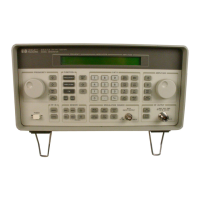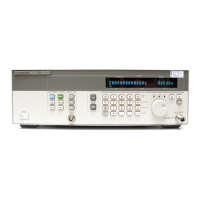5a-11
Theory of Operation
A6 Output (8648A)
A6 Output (8648A)
The output assembly takes the 500 to 1000 MHz signal from the A5 assembly and the
1 GHz LO signal from the A4 assembly to generate the output frequency range of 0.1 to
1000 MHz in three bands. The output assembly also handles the filtering, AM, and
amplitude leveling functions.
The three frequency bands range from 0.1 to 249 MHz, 249 to 501 MHz and 501 to 1000
MHz. The 0.1 to 250 MHz band is heterodyned from the 1 GHz LO signal and the 500 to
1000 MHz main band signal. The 250 to 500 MHz signal is derived by dividing the 500 to
1000 MHz main band signal by two.
Filtering is handled by separate low-pass filters for each frequency band. AM is done using
two separate modulators, one for the divide band and one dual-output modulator for the
main and heterodyne bands. The AM signal from the A3 modulation section for both
modulators is summed into the ALC loop integrator.
Amplitude leveling is handled with an ALC loop to lock the level and an amplitude DAC to
set the level. The error signal from the ALC integrator is sent to either of the two
modulators along with the summed AM signal.
The output assembly contains a calibration EEROM that contains calibration data. This
data must be regenerated anytime an A6 assembly is replaced.
